Peking Union Medical College
Peking Union Medical College (Chinese: 北京协和医学院; pinyin: Běijīng Xiéhé Yīxuéyuàn), founded in 1906, is a selective medical college based in Dongcheng, Beijing, China. It is a Chinese Ministry of Education Double First Class Discipline University, with Double First Class status in certain disciplines.[1] The school is tied to the Peking Union Medical College Hospital and has a joint 8-year clinical medicine science program with Tsinghua University.
中国医学科学院 北京协和医学院 | |
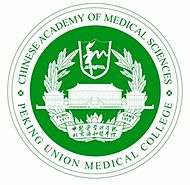 | |
| Type | Public |
|---|---|
| Established | 1917 |
| President | Wang Chen |
| Location | Beijing , China 39.9107°N 116.4149°E |
| Campus | Urban |
| Affiliations | National Health Commission |
| Website | www |
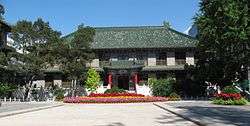
Peking Union Medical College students in the 8-year clinical medicine program could receive a Peking Union Medical College diploma and degree signed by both the Peking Union Medical College and Tsinghua presidents.[2][3][4][5] It was merged with the Chinese Academy of Medical Sciences in 1957 and operates as one single institution with two names directly under the Ministry of Health, now the National Health Commission. It is the first medical school in China to introduce the 8-year M.D. program.
History

The Peking Union Medical College Hospital was founded in 1906. The American Board of Commissioners for Foreign Missions, the Board of Foreign Missions of the Presbyterian Church in the U.S.A., the London Missionary Society, and later, the Board of Foreign Missions of the Methodist Episcopal Church, the Society for the Propagation of the Gospel, and the Medical Missionary Association of London, together with the then-Chinese government cooperated in the foundation and development of the Medical College and maintained it until 1915. The Rockefeller Foundation was established in 1913 and in 1913-1914 the newly formed Foundation created a Commission, including Dr. Franklin C. McLean, to examine medical education in China. One of its recommendations was that the Foundation - through a subsidiary organization - should assume financial responsibility for the College. On July 1, 1915 the recently established China Medical Board assumed full support of the Union Medical College, having previously acquired the property. The Commission's members had included both William Welch, the first Dean of the Johns Hopkins Medical School, and Simon Flexner. The China Medical Board modeled the school after Johns Hopkins University School of Medicine following the recommendations of the Flexner Report, which set the foundation of modern Medical Education in the United States and Canada. The PUMC was reorganized in 1917 and celebrated its 90th anniversary with a ceremony attended by the President of Johns Hopkins University, the Chair of the China Medical Board and representatives of the Rockefeller family and Rockefeller Brothers Fund. John Black Grant, M.D., M.P.H. was a founding faculty member of PUMC and served from 1921-1938 as Professor and Chair of its Department of Public Health. Dr. Grant is the father of James P. Grant, the third executive director of UNICEF.
In January 1951, the new government nationalized PUMC, and the institution was accused of being an agent of American cultural imperialism. The Ministry of Health changed its name to China Union Medical College but did not radically alter the curriculum except to switch the language of instruction from English to Chinese. In 1952 the People's Liberation Army took charge of operations and remained in charge until 1956. The curriculum was militarized and shortened to one year in order to train army medical officers, and Soviet models were introduced. The basic orientation to Western medicine was maintained and the staff continued to do research and advanced surgeries.[6]
In 1956, autonomy was restored, but the college continued to be criticized for its elitism, cosmopolitanism, and failure to "serve the people" during periodic campaigns. [7] During the Cultural Revolution, the Peking Union Medical College was closed, and the hospital was renamed the Beijing Anti-Imperialism Hospital (北京反帝醫院). In 1979, it reopened as the "Capital University of Medical Sciences" then returned to Peking Union Medical College (协和医科大学) in 1985.[8]
Current status
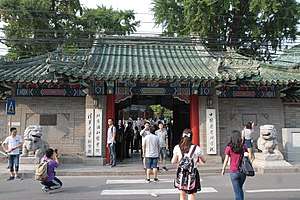
Peking Union Medical College students traditionally attend Peking University biology department for their pre-meds portion of education. Since 2002, Tsinghua University has held a joint MD program in clinical medical science. Enrollment in the clinical medical science at PUMC is based on individual's performance in high school and National Exam score at graduation. The curriculum of clinical medical science is 8 years, accepts about 90 students each year and includes 2.5 years of pre-medical education in the School of Life Sciences at Tsinghua University; the students have their pre-med studies at Tsinghua University and are considered as students of both PUMC and Tsinghua University. The college also has its independent Graduate School, which recruits from other medical schools around the country. The health care services at Peking Union Medical College Hospital are widely believed in mainland China to be among the most technically advanced. Many prominent political and social leaders in China have sought medical treatment at the PUMC Hospital.
Peking Union Medical College has provided generations of leaders for academic and clinical medicine and related areas all over the world.
Peking Union Medical College is part of the Project 211 list of universities receiving national funding.[9]
Research
The medical school is the home to 4 state key labs and 6 WHO collaborating centers including the:
- WHO Collaborating Center for Health and Biomedical Information[10]
- WHO Collaborating Center for the Family of International Classification (WHO-FIC)[11]
- WHO Collaborating Center for Nursing Policy-Making and Quality Management[12]
- WHO Collaborating Center for Traditional Medicine[13]
- WHO Collaborating Centre for the Community Control of Hereditary Diseases (Thalassemia)[14]
- WHO Collaborating Centre for the Prevention and Control of Sexually Transmitted Infections[15]
- The State Key Laboratory of Molecular Oncology[16]
- The State Key Laboratory of Medical Molecular Biology[17]
- The State Key Laboratory of Bio-active substances and the function of natural medicines[18]
- The State Key Laboratory of Experimental Hematology [19]
Hospitals
- Peking Union Medical College Hospital, Beijing
- Fuwai Hospital, Beijing
- Cancer Hospital, Beijing
- Plastic Surgery Hospital, Beijing
- Hematology Hospital, Tianjin
- Skin Disease Hospital, Nanjing
Alumni
- Chen Jirui (Jerry Chen)
- Xin Lu
- Tang Feifan
- Pei Hsien Tang
- Tsai-Fan Yu
- Wu Jieping
- Tian Gang Gary
- Wang Haiqiu Elaine
Gallery
- Peking Union Medical College
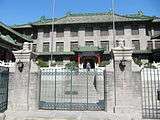
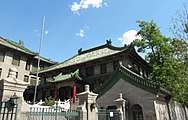
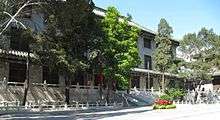
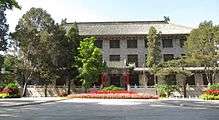

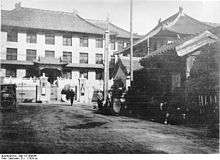

References
Citations
- 教育部 财政部 国家发展改革委 关于公布世界一流大学和一流学科建设高校及建设 学科名单的通知 [Notice from the Ministry of Education and other national governmental departments announcing the list of double first class universities and disciplines] (in Chinese).
- "Tsinghua University". Tsinghua University. Archived from the original on 30 July 2013. Retrieved 18 July 2013.
- "北京协和医学院研究生院介绍". Archived from the original on 2010-12-12. Retrieved 2019-07-14.
- "北京协和医学院研究生院硕士招生信息及文件". Archived from the original on 2010-12-06. Retrieved 2019-07-14.
- "北京协和医学院研究生院博士招生信息及文件". Archived from the original on 2010-12-12. Retrieved 2019-07-14.
- Brazelton (2015), pp. 127-132.
- Brazelton (2015), pp. 142.
- "Peking Hospital Takes Back Pre-1949 Name," New York Times, June 9, 1985
- "The relationship between Peking Union Medical College and Tsinghua University". Retrieved June 1, 2016.
- "WHO Collaborating Centers (9)". Peking Union Medical College. Peking Union Medical College. Archived from the original on 21 January 2016. Retrieved 13 May 2016.
- "WHO Collaborating Centers (9)". Peking Union Medical College. Peking Union Medical College. Archived from the original on 21 January 2016. Retrieved 13 May 2016.
- "WHO Collaborating Centers (9)". Peking Union Medical College. Peking Union Medical College. Archived from the original on 21 January 2016. Retrieved 13 May 2016.
- "WHO Collaborating Centers (9)". Peking Union Medical College. Peking Union Medical College. Archived from the original on 21 January 2016. Retrieved 13 May 2016.
- "WHO Collaborating Centers (9)". Peking Union Medical College. Peking Union Medical College. Archived from the original on 21 January 2016. Retrieved 13 May 2016.
- "WHO Collaborating Centers (9)". Peking Union Medical College. Peking Union Medical College. Archived from the original on 21 January 2016. Retrieved 13 May 2016.
- "Peking Union Medical College". PUMC. PUMC. Archived from the original on 25 May 2016. Retrieved 13 May 2016.
- "Peking Union Medical College". PUMC. PUMC. Archived from the original on 25 May 2016. Retrieved 13 May 2016.
- "Peking Union Medical College". PUMC. PUMC. Archived from the original on 25 May 2016. Retrieved 13 May 2016.
- "Peking Union Medical College". PUMC. PUMC. Archived from the original on 25 May 2016. Retrieved 13 May 2016.
Sources
- Brazelton, Mary Augusta (2015). "Western Medical Education on Trial: The Endurance of Peking Union Medical College, 1949–1985". Twentieth-Century China. 40 (2): 126–145. doi:10.1179/1521538515Z.00000000056.CS1 maint: ref=harv (link)
- Bullock, Mary Brown. An American Transplant: The Rockefeller Foundation and the Peking Union Medical College (Berkeley: University of California Press, 1980).
- McLean, Franklin C, Ph.D., Guide to the Franklin C. McLean Papers 1881-1969 (Special Collections Research Center, University of Chicago Library, 2006).